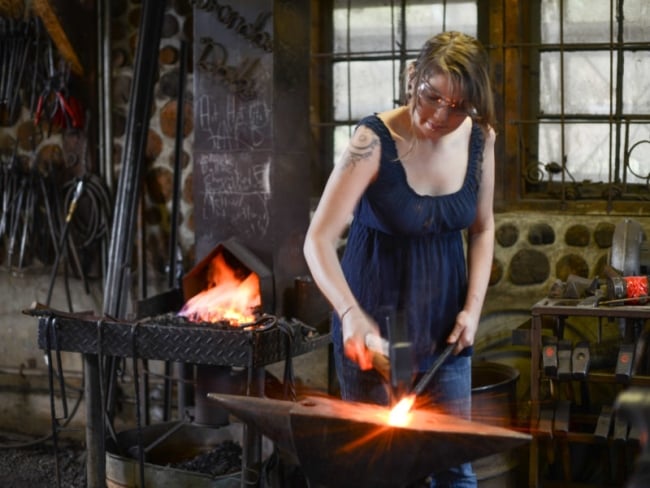You have /5 articles left.
Sign up for a free account or log in.

Student in work program at Warren Wilson College
Warren Wilson College
Experiential learning has been on the rise in higher education as colleges and universities look to amplify so-called high-impact practices, such as service learning, problem and project-based learning, global learning, and work-integrated learning in and out of the classroom. The tremendous growth in the field has also led to confusion about terminology, methods and best practices. As a result, implementation of experiential learning has been uneven, and opportunities exist to clarify and deepen the work.
We have also found a relative lack of basic information about experiential learning in higher education—most scholarly work and resources seem to be centered on K-12 educational contexts. (For an exception, see Steve Mintz’s article “Seize the Power of Experiential Learning.”) As a result, and based on our own experiences in higher education and in our current roles at Warren Wilson College—an institution known for its emphasis on experiential learning—we have developed the following “10 Commandments.” The reference is somewhat tongue-in-cheek, and the list is certainly not inclusive of all principles and practices in the field. But they outline what we think are the key foundational elements that must be present for learning to be labeled as experiential.
No. 1: Frame experiences. Frames create meaning. A common mistake in experiential learning is to either overframe or underframe. Think of gum and chewing. The gum in any teaching and learning situation is the content, and the chewing is the experience. Too much framing is like too much gum—it is hard to chew. Too little framing is like a wafer-thin mint—it’s gone before you know it, and you wonder what the point was in the first place. Overframing is akin to lecturing on and on without giving students a chance to actively work through the material. Underframing is akin to a directionless group project without clear expectations and learning outcomes. Finding the right balance means creating frames that provide context, intrigue and clarity without stifling some degree of open-ended exploration.
For example, more institutions are moving to a required pre-orientation course in advance of a study-away experience or internship for students. Such courses provide structured opportunities for faculty and staff members to meaningfully frame the experience in a variety of ways, pre-exposing students to the academic content, themes and issues that will be present once in the field.
No. 2: Design for student agency. Time and time again, we have seen students come alive and apply their passion to a project when it is born of their own direct experience, interest and direction. When structuring experiential learning, the higher the degree of student agency in selecting a topic, project or experience, the more ownership and empowerment we see in students from beginning to end. Resist the urge to prepackage, and encourage students to respond to their distinct context and the pressing needs around them.
Students in an American history course at one university were given the choice to research places on the campus that were sites of racial conflict during the civil rights era. The resulting project became a powerful “underground campus tour” of those sites of significance and an empowering final assignment for the students and the faculty member.
No. 3: Align experiences with learning outcomes. Clear goals and intentions drive more sophisticated learning and student development. Before engaging in experiential learning, establish your desired learning outcomes and make them contextually relevant.
For example, let’s say a group is to engage with a community partner in an educational setting, to provide tutoring or mentoring to a group of K-12 students. Some potential learning outcomes could include: 1) to reinforce an understanding of how our theories regarding learning relate to our actual practices in the public education system, 2) to refine a set of skills that is responsive to the learner’s needs and is culturally relevant and sensitive, and 3) to understand one’s own strengths and areas for growth as an agent of change in educational settings. Without aligning goals, you can run the risk of the kind of aimless “activity for activity’s sake.”
No. 4: Incorporate substantive reflection. The research is clear: experiences become meaningful and learning is reinforced through reflection and metacognition. A common mistake in experiential learning practice is to minimize reflection or to incorporate shallow, rote forms of reflection. (Anyone who has read unstructured, rambling student journal entries can likely relate.) Not all reflection is created equal. Iteration and variety are important to deepening reflection. Using a combination of modalities—written, visual, narrative, intrapersonal and interpersonal reflection—can also yield more effective and engaged learning. Finally, remember that critical thinking and social awareness come from reflection, and the rise in critical social justice–related work amplifies the importance of deeper, more substantive reflection in experiential learning.
No. 5: Design for relevance, application and meaning making. One guaranteed way to increase the engagement level on assignments for students: make it matter to someone else besides the student and the instructor. So much of our academic work is a private act: a test, exam or paper to be completed and assessed between two people. Assignments and projects that are public in some way up the ante on relevance and meaning. We have seen students present to community partners, to fellow peers, to a client or to their homestay families. Such forms of public presentation and assessment reinforce the real-world applications of learning and foster competencies like public speaking, teamwork and communication that will be relevant as they launch from college to career.
No. 6: Allow for uncertainty and ambiguity as part of the learning process. Many powerful learning experiences come from temporary states of uncertainty and ambiguity. Whether on a study-away experience, in an internship or in a research lab, those moments of uncertainty and ambiguity often yield profound opportunities for growth and change. It may seem counterintuitive to purposefully design opportunities for momentary confusion or doubt, but those states of mind and being can be powerful catalysts for learning. Ask yourself: What healthy risks can I encourage in this class, assignment or experience? How can I foster a tolerance for ambiguity and uncertainty as part of the learning process?
For example, one engineering faculty member decided to ditch his “cookbook-style” assignment and flip his lab class by giving students very little instruction as to how to put the raw materials together for the planned exercise. The resulting confusion among the students generated questions, discussion and debate about the best way to proceed and allowed the faculty member to build on that engagement with just-in-time teaching.
No. 7: Learn alongside your students. Experiential learning is not an expert-driven methodology. It is centered in learning—both for the student and the teacher. While you may be a content-level expert in your field, experiential learning asks you to find ways to engage alongside your students in an effort to build relationships, develop trust and model lifelong learning and a growth mind-set. Admit your mistakes, show them areas where you have learned, find a new unit or content area you can explore with your students, or create assignments and classroom structures where they have an opportunity to teach you.
No. 8: Work with students holistically. One of the great values that experiential learning offers is the opportunity to depart from the strictly cerebral realm that so often characterizes academe and focus more on the psychological, social, emotional and physical dimensions of learning and reflection. Through well-structured experiences, we acquire new skills and develop more empathy and social-emotional attunement, as well as gain a refined understanding of our own distinct offerings and positionality in a group process.
For example, our work program at Warren Wilson allows each student to feel empowered through direct experience with a meaningful job on campus. They build relationships and develop skills working as part of a team, whether on the farm crew or in a research lab. Students also receive frequent feedback from their work supervisor to further their growth and development. This type of holistic learning is common in effective experiential learning contexts—whether through internship, study-away or community engagement experiences—and students often say these types of contexts are the most transformative in their college career.
No. 9: Be flexible and appreciate the role of serendipity in learning. While it’s good practice to plan carefully, design your experiences clearly, establish learning outcomes and align your assessment measures, the beauty of a road trip is not in reaching the final destination but in what you encounter by chance along the way. Experiential learning is much the same. If you can abandon rigidity and overly structured scripts in favor of flexibility—and allow students to take their time and extract learning from mistakes, fumbles or detours—the learning will be more expansive and more joyful for everyone involved.
No. 10: Practice the previous nine commandments through the lens of inclusive excellence. The principles of inclusive excellence highlight the importance of designing curricula and educational experiences with diversity, equity and inclusion first and at the center—and not just as a check box or, worse, an afterthought. Who will be impacted by your project? How will you design for access and inclusion across a range of identities and structural barriers? Who has a voice in the design? How do the values of relationship and reciprocity come through? While research supports the positive benefits of experiential learning for underrepresented student populations, these experiences must be designed through the lens of inclusive excellence in order for the benefits to be realized for all students.
In conclusion, as experiential learning continues to gain recognition as a best practice in higher education, it is increasingly important for faculty and staff, and for institutions, to develop shared language and pedagogical approaches. When done well, experiential learning is transformational for students, teachers and communities.
At Warren Wilson, we have centered experiential learning at the core of our pedagogy since our inception as the Asheville Farm School in 1894. Through the decades, we have witnessed the power of this model. We have also learned a lot about what doesn’t work and is less effective when designing and delivering experiential opportunities. More than any prescribed or fixed method or technique, at its core, experiential learning requires constant self-reflection on the part of the instructor and the institution to adjust and adapt to changing contexts and conditions. The rise of virtual experiential learning is but one example of how the field is constantly evolving.
A main aim of liberal education is to empower students to be self-aware agents of change, prepared for meaningful participation in their communities and civil society. Experiential learning, clearly articulated and consistently applied, can play a prominent and vital role in realizing that goal.








